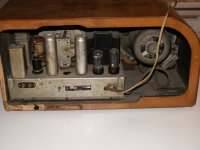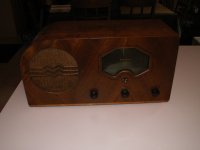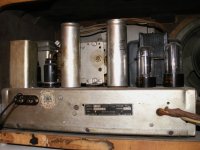A coworker brought me this Westinghouse Canada Model 511 radio today. I mentioned in a conversation a couple of weeks ago that I had an interest in tube amps. He has been collecting them for several years and said he had one that he would give me if I wanted it. Cool! Of course I accepted his charity. So today, sitting in my chair when I came in my office was this beauty.
It powers up and even receives a station or two. The sound is very scratchy. Even walking across the floor near it causes some scratchiness in the sound as the floor vibrates. When I move the tuner dial, VERY scratchy.
It's got 3 bands: SP, MU, P.B. I'm at a loss about these, except I know one of them is AM.
It's also got a volume and tone control.
So, I'm not sure where to start. I'd say the volume and tone control need De-ox'ed and Faderlubed. The tuner needs cleaned, so I suppose that should be next. And then a recap. Somewhere along the way, the bulbs around the tuning scale need replaced too.
Can anyone tell me about this radio? Any advice or suggestions? I can use all the help I can get! Thanks.
Mike
It powers up and even receives a station or two. The sound is very scratchy. Even walking across the floor near it causes some scratchiness in the sound as the floor vibrates. When I move the tuner dial, VERY scratchy.
It's got 3 bands: SP, MU, P.B. I'm at a loss about these, except I know one of them is AM.
It's also got a volume and tone control.
So, I'm not sure where to start. I'd say the volume and tone control need De-ox'ed and Faderlubed. The tuner needs cleaned, so I suppose that should be next. And then a recap. Somewhere along the way, the bulbs around the tuning scale need replaced too.
Can anyone tell me about this radio? Any advice or suggestions? I can use all the help I can get! Thanks.
Mike
Attachments
Cute!
I took the liberty of tweaking the one photo so folks can get a better look at it.
se
I took the liberty of tweaking the one photo so folks can get a better look at it.
se
An externally hosted image should be here but it was not working when we last tested it.
Cute!
I took the liberty of tweaking the one photo so folks can get a better look at it.
se
Thanks!
Wow, does it receive stations without antenna connected? Great!
I would start from replacing filter capacitors. Leave old high cans as is, just unsolder wires from them and put under the chassis a couple of modern caps, they are much smaller in size.
Second, you need to clean a variable capacitor. Most probably some dust between stator and rotor plates caused it to be scratchy. Or sliding contact that grounds the rotor is dirty and oxidized.
Then remove all paper was capacitors and solder instead of them modern film capacitors.
I suggest you to do everything one by one.
You may check also values of all resistors, carbon comp resistors of such an age usually drift a lot.
Then you will need to align it carefully. For the beginning, don't touch IF tuning slugs. Just tune it to the highest frequency (rotor plates off the stator), then carefully adjust trimming capacitor in input selector tank (don't adjust the trimmer in heterodyne can!) by maximal loudness.
I would start from replacing filter capacitors. Leave old high cans as is, just unsolder wires from them and put under the chassis a couple of modern caps, they are much smaller in size.
Second, you need to clean a variable capacitor. Most probably some dust between stator and rotor plates caused it to be scratchy. Or sliding contact that grounds the rotor is dirty and oxidized.
Then remove all paper was capacitors and solder instead of them modern film capacitors.
I suggest you to do everything one by one.
You may check also values of all resistors, carbon comp resistors of such an age usually drift a lot.
Then you will need to align it carefully. For the beginning, don't touch IF tuning slugs. Just tune it to the highest frequency (rotor plates off the stator), then carefully adjust trimming capacitor in input selector tank (don't adjust the trimmer in heterodyne can!) by maximal loudness.
I may end up with a Philco Chassis 89 receiver from my DIL who needs money. I'll end up paying more than it is worth to help her out. I did some research on it and there are lots of web sites dedicated to restoration of old radios.
Take your time and do some studying before you start restoring it. It will pay off in the long run.
Take your time and do some studying before you start restoring it. It will pay off in the long run.
I'm kind of a Westinghouse freak..
Want to do some trading for that radio?
I really can't trade away this radio. It was given to me by a collector and trading it doesn't seem appropriate to me. Thanks for the offer though.
Mike
Hope you get that thing back to 100%, it looks like a real gem!
There was a nifty guide for stripping the old cap cans down, and installing modern capacitors inside them to keep a full factory appearance, If I can find the guys site, ill shoot it your way!
What tubes is it using?
There was a nifty guide for stripping the old cap cans down, and installing modern capacitors inside them to keep a full factory appearance, If I can find the guys site, ill shoot it your way!
What tubes is it using?
Are those screw and nut retained caps?
Here is one restoration process:
Philco Service Hints & Tips, Number 45
Here is one restoration process:
Philco Service Hints & Tips, Number 45
I have an Atwater Kent with that style of electrolytic can capacitor, I'm surprised the radio works at this point because those caps should have dried out by now. (Wet electrolyte type)
I rebuilt mine by cutting off the tops and installing modern electrolytics inside, keeps the chassis uncluttered and period.
The speaker driver appears to be a field coil type, the field coil being an integral part of the power supply Pi filter. I'm glad to see a power transformer.. Check the condition of the wiring to the speaker, and I would replace the frayed jacket with a new one if the insulation on the wires is not too brittle. Otherwise you should replace the entire cable. The line cord should be replaced.
In general it is very bad form to just plug an antique radio straight into the wall without first ascertaining its condition. This a good way to damage irreplaceable parts beyond repair, and the potential fireworks (exploding supply caps, burning power transformers, chokes, etc. ) can be very unpleasant.
I'd guess this is just very slightly pre WWII.
My Atwater Kent 310/510 chassis only needed two new electrolytics to get it going again, everything else was fine. All resistors, mica caps, paper and the magic vane tuning meter were ok - I did need to replace a very limited amount of internal wiring.
Useful links:
Nostalgia Air
Antique Radios - The Collector's Resource
Phil's Old Radios - Welcome!
Antique Radio Websites
Quite a lot of parts at:
Antique Electronic Supply
Radio Daze
I rebuilt mine by cutting off the tops and installing modern electrolytics inside, keeps the chassis uncluttered and period.
The speaker driver appears to be a field coil type, the field coil being an integral part of the power supply Pi filter. I'm glad to see a power transformer.. Check the condition of the wiring to the speaker, and I would replace the frayed jacket with a new one if the insulation on the wires is not too brittle. Otherwise you should replace the entire cable. The line cord should be replaced.
In general it is very bad form to just plug an antique radio straight into the wall without first ascertaining its condition. This a good way to damage irreplaceable parts beyond repair, and the potential fireworks (exploding supply caps, burning power transformers, chokes, etc. ) can be very unpleasant.
I'd guess this is just very slightly pre WWII.
My Atwater Kent 310/510 chassis only needed two new electrolytics to get it going again, everything else was fine. All resistors, mica caps, paper and the magic vane tuning meter were ok - I did need to replace a very limited amount of internal wiring.
Useful links:
Nostalgia Air
Antique Radios - The Collector's Resource
Phil's Old Radios - Welcome!
Antique Radio Websites
Quite a lot of parts at:
Antique Electronic Supply
Radio Daze
Last edited:
I know I'm reviving a really old thread. However, the last time I logged on was back in 2006.  Amazing, I still remember my user name and password on the first try.
Amazing, I still remember my user name and password on the first try.
Thanks to almighty google, I found this thread and I just wanted to say that I have this exact same radio in excellent condition. I think I purchased about 5 years ago at a garage sale. The guy was a collector. I think I picked it up for $80. Everything works and as far as it looks, it's all original.
I wonder how much it's worth now?
Thanks to almighty google, I found this thread and I just wanted to say that I have this exact same radio in excellent condition. I think I purchased about 5 years ago at a garage sale. The guy was a collector. I think I picked it up for $80. Everything works and as far as it looks, it's all original.
I wonder how much it's worth now?
- Status
- This old topic is closed. If you want to reopen this topic, contact a moderator using the "Report Post" button.
- Home
- Amplifiers
- Tubes / Valves
- Got an old Westinghouse radio today!!!


